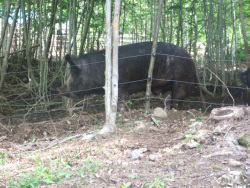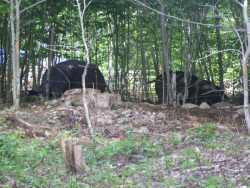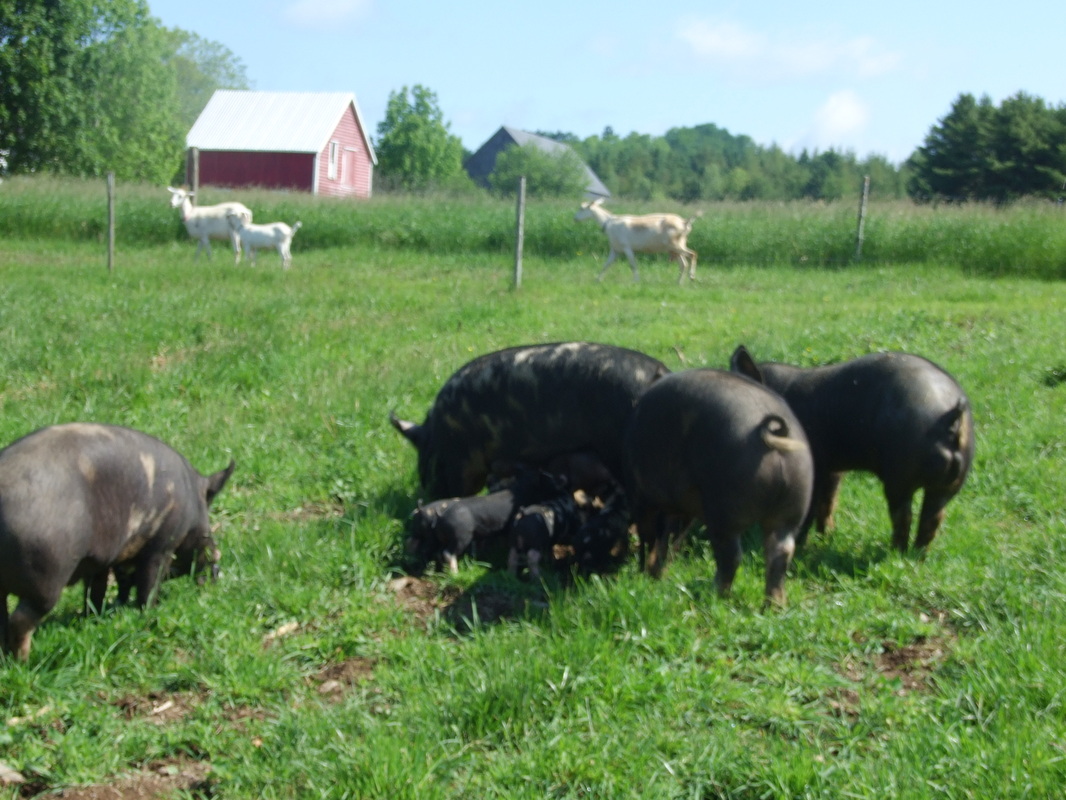Before we talk about housing the pastured pig, please allow me to once again dispell the myth that you can turn a couple of pigs out into a field and expect that they will grow big and strong and then you can kill them for meat in 4 - 6 months.
This is not true. Your pigs will starve or at least fail to gain. Pigs cannot feed themselves on pasture alone. They need feed, specifically protein. Fully grown pigs on a maintenance diet can maintain on pasture with little supplemental feeding . Growing pigs cannot. Before commercial feeds were available, farmers supplemented their feeder pigs diets with turnips, potatoes, sugar beets etc. They also turned them into the grain fields after the harvest. Feeder pigs were born in late winter, raised through the summer and slaughtered in the late fall. The pigs were selected to grow on this routine. Todays pigs are not. Please see pasture pigs part 1 for an explannation.
If you are considering raising feeders on pasture you will need to provide a shelter, minimum of 4 X 8 feet for two pigs . For summer this should face east / north east or where it will catch the prevailing winds, providing this is not south. If there is no natural shade available you need to double the size of the shelter. The structure itself needs to be solid. Pigs will chew wood. Do not go out and
build or buy something that looks like a cover shoot from better farms and
gardens. DO NOT use pressure treated wood.
The shelter should be heavy enough that it can be moved when necessary, but bear in mind that if they set their mind to it, two feeder pigs approaching kill weight can move damn near anything they set their mind to. The shelter must be water tight and draft free. It also needs good ventilation. It does not need to have cathedral ceilings. Especially if you will not be in and out of the shelter on a daily basis. Our shelters are four feet high. Patches and KW have dug out the interior of their shelters during the winter both excavated below ground level. As most pigs will do this to some extent drainage should be considered when deciding where to place the shelter.
Ideally there should be access to a wet area where they can wallow, but they need dry bedding and cannot have their feet wet all the time. Pigs lose a lot of body heat through their feet, like us if their feet are cold, they are cold. If a pig is constantly cold, they will burn calories at a higher rate and will not gain weight.
Bedding can take many forms, shavings, sawdust, straw and sand to name a
few. We bed our pigs with a good layer of sawdust in the pen and then they are
given hay, mostly hay that the goats have picked through, but some fresh in
addition. This is adequate bedding, especially for feeder pigs. Our sow does get
a bale of fresh hay a few days before farrowing so she can build her 'nest'. No
matter what you choose as bedding it must be dry, free from mold and cleaned of foreign material such as sharp sticks and nails. ( Check your sawdust. It
happens).
Your pigs must have access to clean water. Water intake can be better regulated if you wet feed your pigs. Wet feeding is what we recommend. It allows you to know that they are getting water, they digest the feed better and it is easier to combine feeds if you choose to do so. ( I will elaborate on this more in the next post on feed). Supplying pigs with water from a bucket, barrel or trough is unreliable as they are apt to turn it over looking for bugs and worms or just use it as a toy when bored. They will move what ever you think they can't.
Despite their press pigs are clean animals, they will not manure where they sleep. If housed inside a pig will choose a corner of the pen, usually in a drafty or dead air spot, to use for manure and they will keep the rest clean. Pasture pigs will go outside, please consider runoff when choosing your site.Do not put your pigs on the best pasture you have. They will tear it up. If you
have some lovely alfalfa pasture, you can turn them out for a couple of hours
and they will graze a bit. Watch them! It will not take long for them to decide
that they could find some good stuff under that green. Also, do not turn them
onto any good pasture in the spring or after a long wet period. If the ground is
easy to turn over they will. Please keep in mind pigs like to play with trees.
Our beef calf likes to hang out by the pig yard when KW is out as KW will pull
trees over and Ivan eats the leaves off if they come across the fence.
With regard to fencing, two strand electric fence will keep them in. It is what we use it is what we have always used. If you purchase weaner pigs that were raised in a barn or pens with solid fencing you will need to train them regarding electric fencing. This is easily done with a training pen. The easiest way is to put a visible barrier on the outside of the electric fence. Pigs are curious animals they will touch the electric fence. What you don't want is them sticking their head through the fence while checking out their new environment and get shocked. If there is no solid barrier they can jump ahead and go right through the fence. Once a pig figures out they can do something they will do it again. This training period does not take long. A few zaps from the fence and they will stay away from it. You must check your fence regularly. If it is grounding out you will have problems. Pigs are very intelligent animals. Ours know if we turn the fencer off for maintenance. They will learn the sound of the fencer and will test it. You also need to check the level of the fencing. If the pigs are rooting they will pile dirt up against the fence. Electric fencing is most effective if it is at eye level for the pig when their head is down.
Pigs can be put out with other animals, providing the pasture is big enough. If you utilize rotational grazing be sure your fencing is adequate. The pig will remember where the fence was yesterday. It usually will not cross. We always recommend setting up rotational grazing via a corridor. Have the animals exit the barn via the same door everyday and fence off the corridor. This is the least disruptive way for all. We have used this system effectively to graze pasture and allow access to garden leftovers at the end of season It requires a little more planning at the beginning but makes for faster turn around in day to day operations.


They are doing a very effective job of removing the stumps and small trees in this area.



 RSS Feed
RSS Feed
